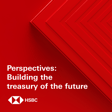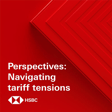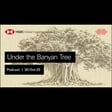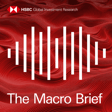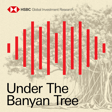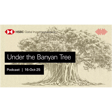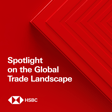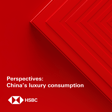Become a Creator today!Start creating today - Share your story with the world!
Start for free
00:00:00
00:00:01

The Macro Brief – The Fed goes big
We look at what the Federal Reserve’s 50 basis point rate cut could mean for the path of future rates, the US economy and global equity markets with Ryan Wang, US Economist, and Alastair Pinder, Head Emerging Markets and Global Equity Strategist. Disclaimer: https://www.research.hsbc.com/R/101/pMGK9cD
Stay connected and access free to view reports and videos from HSBC Global Research follow us on LinkedIn https://www.linkedin.com/feed/hashtag/hsbcresearch/ or click here: https://www.gbm.hsbc.com/insights/global-research.
Access the entire Macro Brief podcast series here: http://macrobrief.research.hsbc.com/
Hosted on Acast. See acast.com/privacy for more information.
Transcript
Introduction
00:00:02
Speaker
Welcome to HSBC Global Viewpoint, the podcast series that brings together business leaders and industry experts to explore the latest global insights, trends, and opportunities.
00:00:13
Speaker
Make sure you're subscribed to stay up to date with new episodes.
00:00:16
Speaker
Thanks for listening.
00:00:17
Speaker
And now onto today's show.
00:00:24
Speaker
This podcast was recorded for publication on the 19th of September, 2024 by HSBC Global Research.
00:00:30
Speaker
All the disclosures and disclaimers associated with it must be viewed on the link attached to your media player.
00:00:34
Speaker
And don't forget that you can follow us on Apple and Spotify or wherever you get your podcasts by searching for The Macro Brief.
Federal Reserve's Easing Cycle
00:00:44
Speaker
Hello, I'm Aline Van Dyne in New York and welcome to the Macro Brief.
00:00:48
Speaker
It's a moment we have all been talking about for many months, the start of the Federal Reserve's easing cycle.
00:00:55
Speaker
Well, it's here and after much speculation about the size of the rate cut, in the end, policymakers opted for a chunky 50 basis point reduction.
00:01:05
Speaker
On today's podcast, we're looking at the state of the U.S. economy, what's next for U.S. interest rates, and what the start of the easing cycle means for global equity markets.
00:01:16
Speaker
And to discuss all this, I'm joined in the studio by Ryan Wang, U.S. economist, and Alistair Pinder, head of EM and global equity strategy.
00:01:26
Speaker
So Ryan, let's start with a quick recap of why the FOMC went for a 50 basis point cut rather than a more conventional 25 basis points.
00:01:37
Speaker
Indeed, this was a long-awaited Fed decision, and we did get the larger rate cut, the 50 basis point size.
00:01:44
Speaker
I think if you put it most straightforwardly, and this is what we heard from Fed Chair Jerome Powell in the press conference, in a way the rate cut reflects greater confidence that inflation has moved lower, that it is moving at least closer to 2%.
00:01:56
Speaker
And in turn, what the decision shows is a shift a little bit away from the elevated inflation of the past two years and more to what's been going on in the labor market.
00:02:05
Speaker
Chair Powell said that by many metrics, including the unemployment rate, actually, the labor market may be a little bit less tight today than it was all the way back in 2019 before the pandemic.
00:02:15
Speaker
We have seen that hiring is still continuing, but at a pace that's much slower than it has been in previous years.
00:02:21
Speaker
And so I think those are really the key drivers that help the Fed make its decision.
U.S. Economy's Resilience and Labor Market
00:02:25
Speaker
In terms of then what it says about the state of the US economy, Ryan, is this bigger cut, 50 basis point cut, signal confidence in economic resilience or is it concerns about economic weakness?
00:02:40
Speaker
Where would you fall on that side of the debate?
00:02:42
Speaker
Well, I think it is a little bit of a nuanced picture.
00:02:44
Speaker
I mean, I think what we do see in the data and Chair Powell did emphasize these themes is that the cooling in the labor market has mostly been on the hiring side, slower rates of hiring rather than a marked acceleration in layoffs.
00:02:58
Speaker
And businesses also generally are not reporting that they're thinking about big time reductions in the size of their workforces.
00:03:07
Speaker
And so what it appears is that the U.S. economy is still growing and it doesn't really appear that there are imminent signs of recession.
00:03:15
Speaker
But at the same time, the Fed, of course, doesn't necessarily want to wait for those signals to emerge before delivering that first rate cut.
00:03:22
Speaker
And because the policy rate is so high still, still even after the latest decision almost at 5 percent on the policy interest rate, that's more or less why the Fed decided to make a bigger move at the beginning to try to bring rates down to closer at least to what might be considered neutral for the economy and no longer as restrictive as has been the case over the past couple of years.
Equity Market Reactions
00:03:45
Speaker
Thanks, Ryan.
00:03:45
Speaker
And of course, you already mentioned the inflation picture earlier.
00:03:49
Speaker
But before we get into what's next for rates, let's bring in Alistair.
00:03:54
Speaker
How have financial markets reacted to the move?
00:03:58
Speaker
Positively, if you look at S&P futures and in the Nasdaq futures, specifically, you know, the equity markets up almost 2%.
00:04:07
Speaker
So it's quite a big rally.
00:04:08
Speaker
And that's been broad based around global equity markets.
00:04:11
Speaker
So Europe has also responded very positively to this, you know, clearly, the markets are signaling that, you know, lower Fed rates should, you know, move into lower bond yields.
00:04:23
Speaker
And that typically is supported for valuations, particularly in
00:04:27
Speaker
if you don't become overly concerned about the economic backdrop.
00:04:31
Speaker
Right.
00:04:31
Speaker
So the interpretation has been more towards economic resilience rather than this is a sign of serious problems.
00:04:39
Speaker
Exactly.
00:04:40
Speaker
And I think one of the interesting things, you know, if you look at equity markets and their performance historically around Fed cuts, you know, what matters is this economic backdrop.
00:04:51
Speaker
The policy easing alone is not that important for equity markets.
00:04:55
Speaker
So to give an example of this, if you look at the performance of the S&P 500 around Fed easing cycles going back to 1965, actually the divergence has depended on one thing.
00:05:06
Speaker
Is the U.S. economy heading into a recession or not?
00:05:09
Speaker
And if it isn't, then equity markets have typically rallied 10% in the following six months.
00:05:14
Speaker
But if that U.S. economy is sharply slowing down, then equity markets are down around 12%.
00:05:19
Speaker
And are there any other historical lessons in terms of what are drivers of the equity markets when an easing cycle kicks in?
00:05:28
Speaker
Well, I think, you know, one of the other key takeaways is just, you know, sector performance and what happens from that perspective.
00:05:34
Speaker
I think there is definitely a perception that maybe cyclicals could do quite well in this current backdrop.
00:05:41
Speaker
But again, looking back historically, there's the message has been quite straightforward.
00:05:44
Speaker
Actually, defensives typically outperform cyclicals.
00:05:48
Speaker
And there's two reasons for this.
00:05:49
Speaker
One is that lower interest rates
00:05:51
Speaker
typically supports their valuations, particularly for some of these long duration sectors.
00:05:56
Speaker
The other aspect to this is that recession or not, the reason why the Fed is easing is because as Ryan mentioned, the economy is slowing.
00:06:05
Speaker
And if that is the case, then typically, defensives perform best in that environment.
00:06:11
Speaker
Thanks, Alistair.
00:06:11
Speaker
So let's switch from kind of the past to the future.
00:06:15
Speaker
Ryan, what can we expect next in terms of US policy rates?
Future Fed Rate Cuts and Economic Outlook
00:06:20
Speaker
Well, I'll start first with our new forecast for Fed rates.
00:06:24
Speaker
We expect that after the 50 base point rate cut delivered in September that the Fed will follow up with 25 base point rate cuts at each of the next six scheduled Fed meetings.
00:06:36
Speaker
So those are the two remaining this year in November and December and then the first four meetings of 2025.
00:06:43
Speaker
And so that would take the federal funds target range from its current four and three quarters to five percent.
00:06:49
Speaker
down to three and a quarter to three and a half percent by the middle of next year.
00:06:53
Speaker
And what are you expecting in terms of the economic picture into 2025?
00:06:57
Speaker
Well, this is really interesting because it partly relates to this debate that I think we can see is unfolding at the Fed with respect to how quickly to reduce that policy rate.
00:07:09
Speaker
Of course, it does have to do a lot with how the economy actually evolves into next year.
00:07:15
Speaker
In particular, I think what I've tried to explain so far is that the initial steps may be more policy normalization, trying to bring rates down to a less restrictive level and not necessarily reacting to imminent signs of economic weakness.
00:07:31
Speaker
So as we go into next year, we'll be keeping a close eye on the monthly job numbers.
00:07:36
Speaker
They have averaged approximately 160,000 per month over the past year once you make some adjustments.
00:07:42
Speaker
So that's still positive jobs growth.
00:07:43
Speaker
But if you slow significantly below that level, well, I think that would be a catalyst for the Fed to become more concerned and the markets as well.
00:07:50
Speaker
If I can just jump in and ask you a question, Ryan, you know, when the Fed started the the hiking cycle, you know, back in 2022, the one of the interesting aspects was that there was always discussion about the lag effects.
00:08:03
Speaker
And because you know, some of the debt composition had changed, and maybe the impact on the real economy wasn't going to materialize as quickly as we had seen in previous cycles.
00:08:12
Speaker
So what does this mean in terms of, you know, when the Fed starts cutting interest rates?
00:08:16
Speaker
Do you think it's going to have as big of an impact on the economy as we've seen previously?
00:08:20
Speaker
Well, I think this is an extremely interesting question.
00:08:23
Speaker
And what I would say is that when you talk about rate hikes and then rate cuts on the way down, the impact is different depending on whether you're talking about the shorter end of interest rates or the longer end.
00:08:33
Speaker
And of course, we know in the US, for example, that long rates have a big effect on the housing market.
00:08:38
Speaker
But the short end, you know, that matters as well for borrowers, whether it's households that are borrowing through the consumer channels or smaller businesses or even if we talk about commercial real estate projects that need financing.
00:08:50
Speaker
Well, in each of these instances, oftentimes the short rate can matter quite a lot.
00:08:53
Speaker
And that's part of the reason why this decision about 25 versus 50 base points at a particular meeting, it's not theoretical.
00:09:00
Speaker
It's a very practical decision that makes a difference for all those types of borrowers.
00:09:04
Speaker
So on those borrowers, Ryan, any comments or just a summary of the state of the U.S.
Financial Stress and Borrowers
00:09:11
Speaker
consumer?
00:09:11
Speaker
How resilient is that part of the economic picture?
00:09:15
Speaker
I think what you see in the U.S. is still very much a divergence.
00:09:18
Speaker
The aggregate numbers are holding up pretty well, but I think you do see signs, growing signs really, of financial stress for many households, particularly lower-income households that are struggling with the high price level from basic necessities like groceries.
00:09:32
Speaker
I think that is coming through in the data, and also businesses are reporting that their consumers are becoming more price sensitive, less able to absorb these big price increases of recent years, and that's
00:09:44
Speaker
Another sign that as we go into the year ahead, yes, growth is likely to continue to slow.
00:09:51
Speaker
And the question is whether it slows in a fashion that would really signify an economic downturn.
Impact of U.S. Election on Economic Policy
00:09:56
Speaker
And of course, a discussion for another day, but it would be remiss not to mention that the U.S. election could have an impact on all these things.
00:10:04
Speaker
Just a quick mention, what are the main policy areas that you would be looking out for?
00:10:10
Speaker
Yeah, it certainly is going to be topical.
00:10:12
Speaker
Just to mention it, the next Fed meeting actually occurs a few days after the November election.
00:10:18
Speaker
And so, you know, when we think about the perspective size of the next rate cut, for example, of course, that's something else to consider.
00:10:26
Speaker
It'll be right after the election outcome.
00:10:30
Speaker
Now, as we look into next year, there are several policy areas that clearly could impact both the path of the economy and therefore the prospective path of Fed easing.
00:10:37
Speaker
Those could include things like tax policy, tariffs, immigration policy also, and changes in immigration have had a big effect on the U.S. economy over recent years.
00:10:48
Speaker
So those are just three very important policy areas where the election results could matter greatly.
00:10:53
Speaker
I think, you know, the big areas are going to be on trade and tariff policy.
00:10:58
Speaker
And, you know, as Ryan mentioned, corporate tax in the US, I think that's going to have the biggest impact on regional divergences of equity markets across the globe.
00:11:09
Speaker
Thank you both
Next Live Insight Series Announcement
00:11:10
Speaker
so much.
00:11:10
Speaker
Look forward to further updates as we see what unfolds in the US.
00:11:15
Speaker
Thanks very much.
00:11:20
Speaker
Now, before we go, here's your last call for the next edition of our Live Insight series.
00:11:25
Speaker
On the 25th of September, we'll be looking at the latest evidence of physical climate impacts across G20 countries.
00:11:34
Speaker
And you'll have the chance to put your questions to James Ridge, head of ESG research in EMEA.
00:11:40
Speaker
For more details on how to sign up for that and anything else we've talked about today, please email askresearch at hsbc.com.
00:11:49
Speaker
And don't forget that if you are a client of HSBC Global Research, you can download our mobile app and keep track of all the reports that we're publishing.
00:12:02
Speaker
So that wraps things up for today.
00:12:04
Speaker
Please join us next week for another edition of The Macro Brief.
00:12:30
Speaker
Thank you for joining us at HSBC Global Viewpoint.
00:12:34
Speaker
We hope you enjoyed the discussion.
00:12:36
Speaker
Make sure you're subscribed to stay up to date with new episodes.
